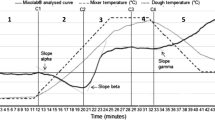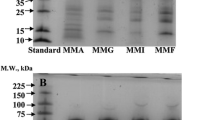Abstract
The functional and rheological properties of amaranth albumins isolates extracted from two new Mexican varieties were determined. Functional properties tested were protein solubility, foaming, water and oil absorption capacities, emulsifying activity, and emulsion stability. The maximum solubility values for both amaranth albumins were found above pH 6 and values were compared to the solubility of egg albumins. Albumins from amaranth showed excellent foaming capacity and foaming stability at pH 5, suggesting that this protein could be used as whipping agents as egg albumins, also the water and oil absorption capacities reached their maximum values at acidic pH, suggesting that amaranth albumins could be appropriate in preparation of acidic foods. The rheological test based on farinograms and alveograms showed that wheat flour supplemented with 1% amaranth albumins improves the dough properties due to higher mixing stability and the bread had better crumb characteristics. In addition of the known high nutritional values of amaranth albumins, our results indicate the high potential for use of these proteins as an ingredient in food preparations.
Similar content being viewed by others
References
Dowton WJS (1973) Amaranthus edulis: A high lysine grain amaranth. World Crops 25: 20–46.
Konishi Y, Fumita Y, Ikeda K, Okuno L, Fuwa H (1985) Isolation and characterization of globulin from seeds of Amaranthus hypochondriacus L. Agric Biol Chem 49: 1453–1455.
Konishi Y, Yoshimoto N (1989) Amaranth globulin as a heat-stable emulsifying agent. Agric Biol Chem 53: 3327–3331.
Barba de la Rosa AP, Gueguen J, Paredes-López O, Viroben G (1992) Fractionation procedures, electrophoretic characterization and amino acid composition of amaranth seed protein. J Agric Food Chem 40: 931–936.
Barba de la Rosa AP, Paredes-López O, Gueguen J (1992) Characterization of amaranth globulins by ultracentrifugation and chromatographic techniques. J Agric Food Chem 40: 937–940.
Segura-Nieto M, Barba de la Rosa AP, Paredes-López O (1994) Biochemistry of amaranth proteins. In: Paredes-López O (ed), Amaranth: Biology, Chemistry, and Technology. Boca Raton, FL: CRC Press, pp 75–106.
Marcone MF, Kakuda Y (1999) A comparative study of the functional properties of amaranth and soybean globulin isolates. Nahrung 43: 368–373.
Segura-Nieto M, Vázquez-Sánchez N, Rubio-Velázquez H, Olguín-Martínez LE, Rodríguez-Nester CE, Herrera-Estrella L (1992) Characterization of amaranth (Amaranthus hypochondriacus L.) seed proteins. J Agric Food Chem 40: 1553–1558.
Osborne TB (1924) The Vegetable Proteins. Monographs in Biochemistry, 2nd edn. Longmas, NY: Green and Co., p 25.
Valdés-Rodríguez S, Segura-Nieto M, Chagolla-López A, Vargas-Cortinas VA, Martínez-Gallardo N, Blanco-Labra A (1993) Purification, characterization and complete amino acid sequence of a trypsin inhibitor from amaranth (Amaranth hypochondriacus) seeds. Plant Physiol 103: 1407–1411.
Broekaert WF, Marion W, Terras FRG, DeBolle MFC, Proost P, VanDamine J, Dillen L, Claeys M, Rees S, Vanderleyden J, Cammue BPA (1992) Antimicrobial peptides from Amaranthus caudatus seeds with sequence homology to the cysteine/glycine-rich domain of chitin binding proteins. Biochemistry 31: 4308.
Schnetzler KA, Breene WM (1994) Food uses and amaranth product research. In: Paredes López O (ed), Amaranth: Biology, Chemistry, and Technology. Boca Raton, FL: CRC Press, pp 155–184.
Barba de la Rosa AP, Paredes-López O (1989) Development of an enzymatic procedure to produce high-protein amaranth flour. Biotechnol Lett 11: 442–448.
Bradford MM (1976) A rapid and sensitive method for the quantitation of microgram quantities of protein utilizing the principle of protein-dye binding. Anal Chem 72: 248.
Okezie BO, Bello AB (1988) Physicochemical and functional properties of winged bean flour and isolate compared with soy isolate. J Food Sci 53: 450–454.
Neto V, Narain Q, Silva N, Bora J (2001) Functional properties of raw and heat processed cashe nut (Anacardium occidentale, L.) kernel protein isolates. Nahrung/Food 45: 258–262.
Reyes-Castañeda P (1983) Bioestad Ística Aplicada. Agronomía, Biología, Química. Mexico: Ed. Trillas.
Paredes-López O, Barba de la Rosa AP, González-Castañeda J (1987) Physicochemial and functional properties of mexican wheat flours for breadmaking. Cereal Foods World 32: 602–603.
Zheng H, Morgensternt MP, Campanella OH, Larsen NG (2000) Rheological properties of dough during mechanical dough development. J Cereal Sci 32: 293–306.
Molinera de México, Grupo Gruma. Carretera Panamericana Km 366.5 Celaya, Guanajuato C.P. 38020, Celaya, Guanajuato-México.
Gueguen J, Popineau Y, Anisimova IN, Fido RJ, Cegrí PR, Tatham AS (1996) Functionality of the 2S albumin seed storage proteins from sunflower (Helianthus annuus L.). J Agric Food Chem 44: 1184–1189.
Hiettiarachcy NC, Kalapathy V (1998) Functional properties of soy proteins. Functional properties of proteins and lipids. In: Withaker JR, Shahide F, López-Munguía A, Yada RY, Fuller A (eds), ACS Symposium Series, Washington, DC, 1997, pp 80–95.
Sathe SK, Desphande SS, Salunkhe DK (1982) Functional properties of winged bean (Psophocarpus tetragonolobus (L.) DC) proteins. J Food Sci 47: 503–507.
Chakraborty S, Chakraborty N, Datta A (2000) Increased nutritive value of transgenic potato by expressing a nonallergenic seed albumin gene from Amaranthus hypochondriacus. PNAS 97: 3724–3729.
Barro F, Rooke L, Békés F, Gras P, Tatham AS, Fido R, Lazzeri PA, Shewery PR, Barceló P (1997) Transformation of wheat with high molecular weight subunit genes results in improved functional properties. Nature Biotechnol 15: 1295–1299.
Author information
Authors and Affiliations
Corresponding author
Rights and permissions
About this article
Cite this article
SILVA-SÁNCHEZ, C., GONZÁLEZ-CASTAÑEDA, J., DE LEÓN-RODRÍGUEZ, A. et al. Functional and Rheological Properties of Amaranth Albumins Extracted From Two Mexican Varieties. Plant Foods Hum Nutr 59, 169–174 (2004). https://doi.org/10.1007/s11130-004-0021-6
Issue Date:
DOI: https://doi.org/10.1007/s11130-004-0021-6




